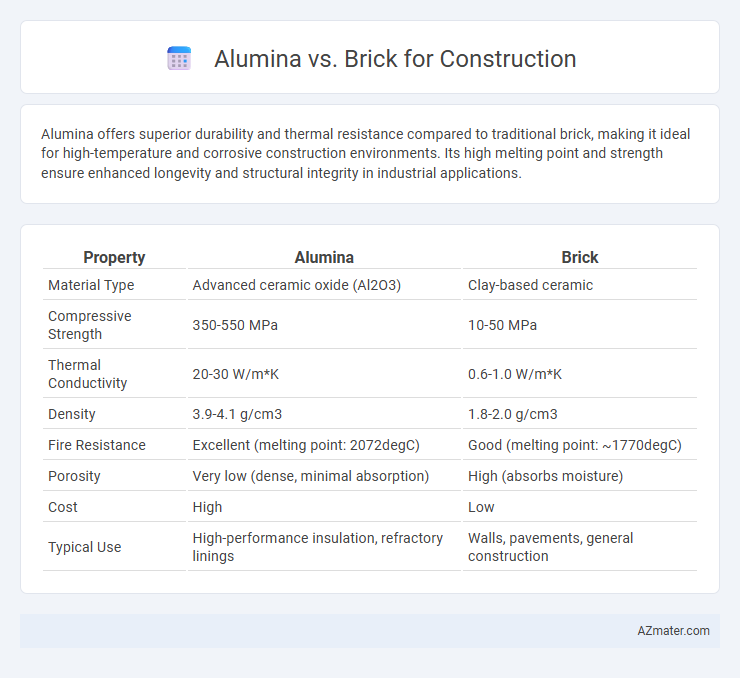Alumina offers superior durability and thermal resistance compared to traditional brick, making it ideal for high-temperature and corrosive construction environments. Its high melting point and strength ensure enhanced longevity and structural integrity in industrial applications.
Table of Comparison
| Property | Alumina | Brick |
|---|---|---|
| Material Type | Advanced ceramic oxide (Al2O3) | Clay-based ceramic |
| Compressive Strength | 350-550 MPa | 10-50 MPa |
| Thermal Conductivity | 20-30 W/m*K | 0.6-1.0 W/m*K |
| Density | 3.9-4.1 g/cm3 | 1.8-2.0 g/cm3 |
| Fire Resistance | Excellent (melting point: 2072degC) | Good (melting point: ~1770degC) |
| Porosity | Very low (dense, minimal absorption) | High (absorbs moisture) |
| Cost | High | Low |
| Typical Use | High-performance insulation, refractory linings | Walls, pavements, general construction |
Introduction to Alumina and Brick in Construction
Alumina, a highly durable and heat-resistant material derived from bauxite, is increasingly utilized in specialized construction applications requiring enhanced strength and thermal stability. Bricks, traditionally made from fired clay, remain a cornerstone in construction due to their affordability, ease of manufacture, and excellent compressive strength. Comparing alumina and brick involves assessing factors such as mechanical properties, thermal insulation, and cost-efficiency, guiding optimal material selection for specific structural needs.
Material Composition and Properties
Alumina, primarily composed of aluminum oxide (Al2O3), exhibits high hardness, excellent corrosion resistance, and exceptional thermal stability, making it ideal for high-performance construction applications requiring durability and wear resistance. Bricks, typically made from clay and shale, offer good compressive strength and thermal insulation but are more porous and less resistant to chemical attack compared to alumina. The significant difference in material composition results in alumina's superior mechanical properties and longevity, while bricks provide cost-effective, traditional building solutions with adequate structural support.
Thermal Insulation Comparison
Alumina offers superior thermal insulation in construction due to its low thermal conductivity, effectively reducing heat transfer and improving energy efficiency in buildings. Brick, while durable and widely used, typically has higher thermal conductivity, making it less effective for insulating purposes compared to alumina-based materials. Choosing alumina over brick enhances thermal performance, leading to better temperature regulation and reduced energy costs in construction projects.
Strength and Durability Analysis
Alumina-based materials exhibit superior strength and enhanced wear resistance compared to traditional bricks, making them ideal for high-stress construction environments. Their high alumina content contributes to excellent durability, chemical stability, and thermal resistance, outperforming conventional clay bricks in longevity. This makes alumina a preferred choice for industrial and infrastructure projects requiring robust, long-lasting structural components.
Moisture and Weather Resistance
Alumina materials offer superior moisture resistance compared to traditional bricks, making them ideal for construction in humid or wet environments. Their low porosity prevents water absorption, significantly reducing the risk of damage from freeze-thaw cycles and mold growth. In contrast, bricks tend to absorb moisture, which can lead to structural weakening and increased maintenance requirements over time.
Fire Resistance Capabilities
Alumina tiles offer exceptional fire resistance due to their high melting point around 2,072degC, making them ideal for high-temperature applications in industrial construction. Brick, while traditionally used for fire-resistant walls, typically has a lower fire resistance threshold, with refractory bricks melting around 1,700degC, which may limit use in extreme heat environments. Choosing alumina enhances fire protection in construction projects where durability against intense heat and thermal shock is critical.
Environmental Impact and Sustainability
Alumina bricks offer superior environmental benefits due to their longer lifespan and resistance to high temperatures, reducing the need for frequent replacements and minimizing waste. Compared to traditional clay bricks, alumina bricks require less energy during manufacturing, leading to lower carbon emissions and a smaller ecological footprint. Their enhanced durability and thermal efficiency contribute significantly to sustainable construction practices by improving energy conservation and reducing resource consumption.
Cost and Availability
Alumina offers higher durability and heat resistance but generally comes at a higher cost compared to traditional bricks, making it less economical for large-scale construction projects. Bricks are widely available, cost-effective, and sourced locally in most regions, which significantly reduces transportation expenses and overall construction costs. The choice between alumina and brick often depends on project budget constraints and the availability of materials in the local market.
Installation and Maintenance Requirements
Alumina panels offer quicker installation due to their lighter weight and prefabricated modular design, reducing labor costs and on-site assembly time compared to traditional bricks. Maintenance requirements for alumina involve periodic cleaning and inspections for surface damage, with high resistance to corrosion and weathering enhancing durability. In contrast, brick installation is labor-intensive and time-consuming, requiring skilled masonry, while maintenance includes repointing mortar joints and addressing potential brick spalling over time.
Best Applications for Alumina and Brick
Alumina excels in high-temperature industrial applications such as refractory linings, kiln furniture, and furnace insulation due to its exceptional thermal stability, chemical inertness, and mechanical strength. Bricks, particularly clay bricks, are preferred for general construction, load-bearing walls, and facades because of their cost-effectiveness, ease of manufacturing, and excellent compressive strength. Alumina-based materials are ideal for specialized environments requiring corrosion resistance and high wear endurance, while bricks are best suited for structural building and aesthetic architectural purposes.

Infographic: Alumina vs Brick for Construction
 azmater.com
azmater.com